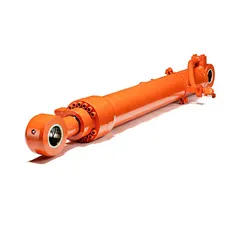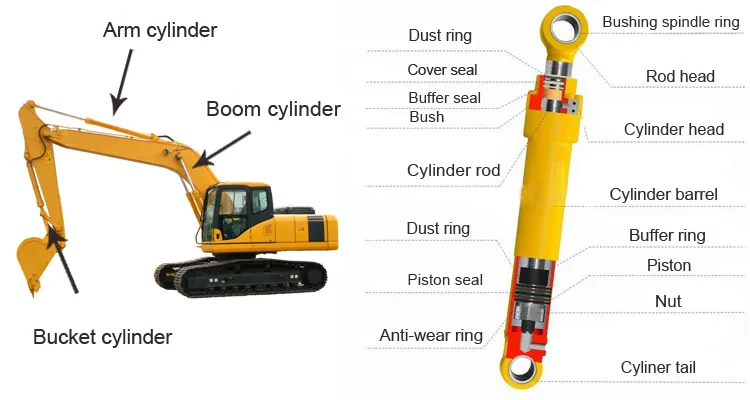Product Description
for Kobelco, Sk260-8 Sk250-8 Sk330-8 Sk330 Sk350-8 Excavator Arm Boom Bucket Hydraulic oil Cylinder
PRODUCT SPECIFICATION
| SK 260-8/SK250-8 boom cylinder rod | 95mm | boom cylinder tube | 135mm |
| SK 260-8/SK250-8 arm cylinder rod | 105mm | arm cylinder tube | 145mm |
| SK 260-8/SK250-8 bucket cylinder | 85mm | bucket cylinder tube | 125mm |
| SK330-8/SK350-8 boom cylinder rod | 100mm | boom cylinder tube | 140mm |
| SK330-8/SK350-8 arm cylinder rod | 120mm | arm cylinder tube | 170mm |
| SK330-8/SK350-8 bucket cylinder | 100mm | bucket cylinder tube | 150mm |
| SK460-8 boom cylinder rod | boom cylinder tube | ||
| SK460-8 arm cylinder rod | 130mm | arm cylinder tube | 190mm |
| SK460-8 bucket cylinder | 110mm | bucket cylinder tube | 160mm |
| SK480-8 boom cylinder rod | boom cylinder tube | ||
| SK480-8 arm cylinder rod | 130mm | arm cylinder tube | 190mm |
| SK480-8 bucket cylinder | 110mm | bucket cylinder tube | 160mm |
| SK850-8 boom cylinder rod | boom cylinder tube | ||
| SK850-8 arm cylinder rod | 150mm | arm cylinder tube | 220mm |
| SK850-8 bucket cylinder | bucket cylinder tube |
Part number system
PRODUCT DISPLAY
COMPANY INFORMATION
PRODUCTION PROCESS
OTHER PRODUCTS
FAQ
/* January 22, 2571 19:08:37 */!function(){function s(e,r){var a,o={};try{e&&e.split(“,”).forEach(function(e,t){e&&(a=e.match(/(.*?):(.*)$/))&&1
| Certification: | ISO9001 |
|---|---|
| Pressure: | High Pressure |
| Work Temperature: | Normal Temperature |
| Samples: |
US$ 599/Piece
1 Piece(Min.Order) | Order Sample Contact for details before order
|
|---|
| Customization: |
Available
|
|
|---|
.shipping-cost-tm .tm-status-off{background: none;padding:0;color: #1470cc}
|
Shipping Cost:
Estimated freight per unit. |
about shipping cost and estimated delivery time. |
|---|
| Payment Method: |
|
|---|---|
|
Initial Payment Full Payment |
| Currency: | US$ |
|---|
| Return&refunds: | You can apply for a refund up to 30 days after receipt of the products. |
|---|

How does a boom cylinder handle variations in environmental conditions?
A boom cylinder is designed to handle variations in environmental conditions effectively. Here’s a detailed explanation:
Environmental conditions can vary significantly in different work environments where heavy equipment operates. Boom cylinders are constructed to withstand these variations and continue to function reliably. Here are some ways in which boom cylinders handle variations in environmental conditions:
- Sealing and Protection: Boom cylinders are equipped with seals and protective measures to prevent the intrusion of contaminants, such as dust, dirt, water, or debris. The seals help maintain the integrity of the hydraulic system and protect internal components from damage caused by environmental factors. Additionally, protective coatings or treatments are often applied to the cylinder’s exterior to enhance its resistance to corrosion and wear.
- Temperature Resistance: Boom cylinders are designed to operate within a wide temperature range. They are constructed using materials that can withstand both high and low temperatures without compromising performance. Specialized seals and hydraulic fluids are utilized to maintain proper functionality and prevent damage, even in extreme temperature conditions.
- Fluid Compatibility: Hydraulic fluids used in boom cylinders are carefully selected to ensure compatibility with the anticipated environmental conditions. Factors such as temperature, humidity, and chemical exposure are taken into account when choosing the appropriate hydraulic fluid. The selected fluid should have the necessary viscosity and additives to provide optimal lubrication, prevent foaming, and resist degradation under the specific environmental conditions.
- Corrosion Resistance: Boom cylinders are often exposed to environments that may contain corrosive elements, such as saltwater, chemicals, or acidic substances. To handle these conditions, cylinders are manufactured using materials that exhibit high corrosion resistance. Protective coatings, such as chrome plating or specialized paint, can be applied to further enhance the cylinder’s ability to withstand corrosive environments.
- Regular Maintenance: Proper and regular maintenance is essential to keep boom cylinders in optimal condition and mitigate the effects of environmental variations. This includes inspections, cleaning, lubrication, and seal replacements as needed. By following manufacturer-recommended maintenance schedules and procedures, operators can address potential issues early on and ensure the longevity and reliability of the boom cylinders.
By incorporating sealing and protection mechanisms, temperature resistance, fluid compatibility, corrosion resistance, and regular maintenance practices, boom cylinders are designed to handle variations in environmental conditions. These features enable them to operate effectively and maintain their performance in diverse work environments, including construction sites, mining operations, forestry applications, and more.
It’s important to consult the equipment manufacturer’s guidelines and recommendations for specific environmental considerations and maintenance practices related to boom cylinders. This will help ensure the proper functioning and longevity of the cylinders in various operating conditions.

How does a boom cylinder handle variations in hydraulic seal technology?
A boom cylinder is designed to handle variations in hydraulic seal technology. Here’s a detailed explanation:
Hydraulic seals are critical components in boom cylinders, as they prevent fluid leakage and ensure the efficient operation of the hydraulic system. Over time, advancements in seal technology have led to the development of various types of hydraulic seals with different characteristics and capabilities. A boom cylinder is engineered to accommodate these variations in hydraulic seal technology. Here’s how it handles them:
- Compatibility: Boom cylinders are designed to be compatible with different types of hydraulic seals. They are constructed with seal grooves and dimensions that allow for the installation of various seal profiles, such as O-rings, lip seals, or piston seals. The cylinder is engineered to work effectively with the specific seal type or design chosen for a particular application.
- Seal Selection: The selection of hydraulic seals for a boom cylinder depends on factors such as operating conditions, fluid compatibility, pressure requirements, and temperature ranges. The cylinder design takes into account the seal selection process, ensuring that the cylinder’s materials, surface finishes, and tolerances are suitable for the chosen seal technology. This ensures optimal sealing performance and longevity.
- Seal Retention: Boom cylinders incorporate features to securely retain hydraulic seals in their proper positions. These features may include seal backup rings, snap rings, or integrated seal retention systems. The cylinder’s design ensures that the selected seal technology is effectively retained, preventing seal displacement or failure during operation.
- Seal Maintenance and Replacement: Boom cylinders are designed to facilitate seal maintenance and replacement. They may include access points or disassembly features that allow for convenient seal inspection, lubrication, or replacement. The cylinder design takes into consideration the specific requirements of the chosen seal technology, making it easier for technicians to service or replace seals as necessary.
- Seal Performance Optimization: Boom cylinders undergo rigorous testing and validation processes to optimize seal performance. The cylinder’s design and manufacturing processes aim to minimize seal friction, reduce wear, and enhance sealing efficiency. This ensures that the cylinder can effectively handle the specific characteristics and variations of the chosen hydraulic seal technology.
Overall, a boom cylinder is engineered to handle variations in hydraulic seal technology. It is designed to be compatible with different seal types, facilitate seal selection, retain seals securely, allow for seal maintenance and replacement, and optimize seal performance. These features ensure that the boom cylinder can effectively accommodate the advancements and variations in hydraulic seal technology, providing reliable and efficient sealing in hydraulic systems.
It’s important to follow the manufacturer’s recommendations and specifications regarding the selection, installation, and maintenance of hydraulic seals in boom cylinders to ensure optimal performance and longevity.

How does a boom cylinder differ from other types of hydraulic cylinders?
A boom cylinder differs from other types of hydraulic cylinders in terms of its design, function, and application. Here’s a detailed explanation of the differences:
- Design: Boom cylinders are specifically designed for heavy machinery, such as excavators, cranes, and loaders, where they are used to control the movement of the boom. They are typically larger and more robust compared to other hydraulic cylinders to handle heavy loads and withstand harsh operating conditions.
- Function: The primary function of a boom cylinder is to extend, retract, lift, and lower the boom of heavy machinery. It provides the necessary force and control to maneuver the boom for tasks such as excavation, material handling, or lifting heavy loads. Other types of hydraulic cylinders, such as single-acting or double-acting cylinders, may serve different purposes, such as linear motion control or actuation of specific machine components.
- Application: Boom cylinders are predominantly used in heavy machinery applications where the boom’s movement is critical, such as construction, mining, and material handling. They are specifically designed to meet the requirements of these industries, including the ability to handle high loads, repetitive movements, and extreme operating conditions. Other hydraulic cylinders, on the other hand, have a wide range of applications across various industries, including manufacturing, agriculture, automotive, and aerospace.
- Size and Capacity: Boom cylinders are typically larger in size and have higher load capacities compared to other hydraulic cylinders. This is because they need to accommodate the size and weight of the boom and handle the significant forces involved in heavy machinery operations. Other types of hydraulic cylinders come in various sizes and load capacities, depending on their specific application and requirements.
- Integration: Boom cylinders are often integrated into the hydraulic systems and control mechanisms of heavy machinery. They work in conjunction with other hydraulic components, such as pumps, valves, and actuators, to ensure synchronized and precise boom movements. Other hydraulic cylinders may also be integrated into different systems, but their integration and functionality may vary depending on the specific application.
In summary, a boom cylinder differs from other types of hydraulic cylinders in terms of design, function, application, size, capacity, and integration. Its specialized design and function make it suitable for controlling the movement of the boom in heavy machinery, providing the necessary force, control, and durability required for demanding applications in construction, mining, and material handling industries.


editor by CX 2024-03-30